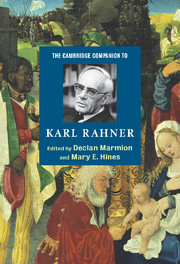Book contents
- Frontmatter
- Introduction
- Part I Spiritual, Philosophical, and Theological Roots
- Part II Theological Investigations
- Part III Conversations Ongoing
- 12 Rahner amid modernity and post-modernity
- 13 Rahner’s reception in twentieth century Protestant theology
- 14 Karl Rahner
- 15 Rahner and religious diversity
- 16 Political and liberation theologies
- 17 Feminist theologies
- Part IV Retrospect and Prospect
- Appendix
- Index
14 - Karl Rahner
toward a theological aesthetics
from Part III - Conversations Ongoing
Published online by Cambridge University Press: 28 May 2006
- Frontmatter
- Introduction
- Part I Spiritual, Philosophical, and Theological Roots
- Part II Theological Investigations
- Part III Conversations Ongoing
- 12 Rahner amid modernity and post-modernity
- 13 Rahner’s reception in twentieth century Protestant theology
- 14 Karl Rahner
- 15 Rahner and religious diversity
- 16 Political and liberation theologies
- 17 Feminist theologies
- Part IV Retrospect and Prospect
- Appendix
- Index
Summary
It may come as a surprise to include an article on Rahner's contribution to a theological aesthetics in this Companion. This theme in Rahner has hitherto received only little attention. However, it seems timely to consider this aspect of his writings here, as it will throw new light on Rahner's theology as such and demonstrate his continued relevance in theology and, in particular, in the current development of the dialogue between theology and the arts.
The quest for a theological aesthetics, including a theology of art, has become a significant theme in theology since the early 1980s. The numerous publications on theology and art, literature, music, and film, etc. and the setting up of whole programs and departments in theological faculties witness to this development. The overall aim in such endeavors is to investigate how the arts are sources of, and can play an active role in, theology. It is precisely such questions that Rahner addressed in his articles on the arts.
Rahner was in many ways a prophetic voice in twentieth century Christianity. His idea that the Christian of the future would need to be a mystic is reflected in today’s interest in diverse forms of spirituality, i.e., in the search for and reflection on religious experience in an age of pluralism. Rahner’s leitmotif is the God who reveals Godself in all realms of life, in human experience, as holy mystery, the God who communicates Godself through grace, yet who remains always wholly Other. Rahner saw the whole of human existence and of history as embraced by God’s transforming love and presence. In his many essays, meditations, and sermons he tried to bring across to the most diverse audiences, including those with serious doubts about Church and faith, this mystery of a loving God. In this context it does not surprise that he would engage with the question of the arts as sources of revelation and meaning and their role in theology.
- Type
- Chapter
- Information
- The Cambridge Companion to Karl Rahner , pp. 225 - 234Publisher: Cambridge University PressPrint publication year: 2005
- 1
- Cited by

